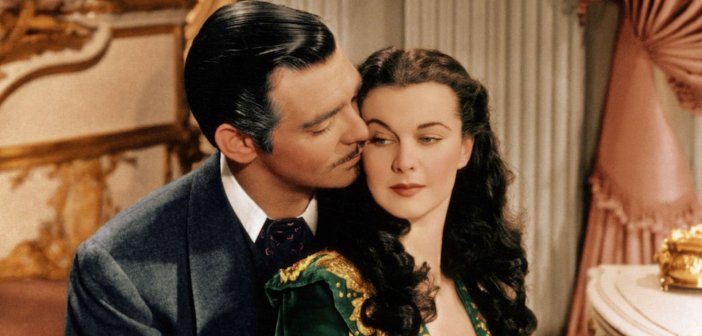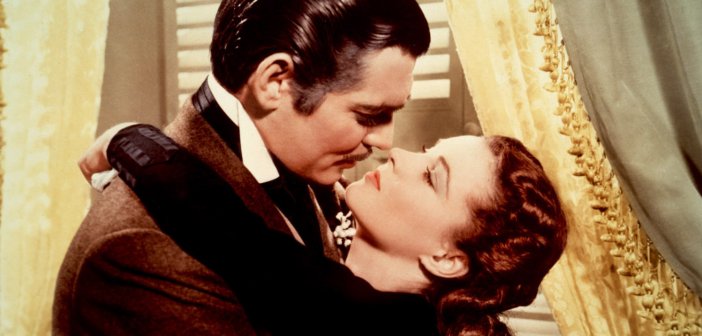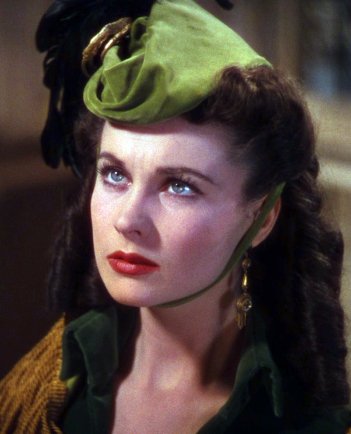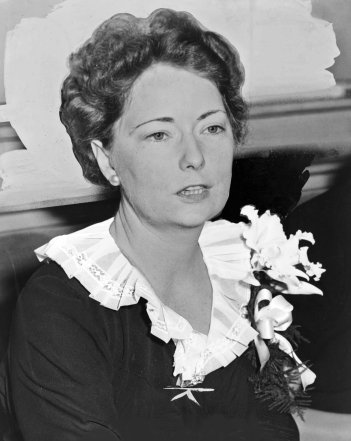Literature on Film | 17 | Gone With the Wind‘s Theme of the Fall of the South has Staying Power
What’s your favourite film moment? ET lisping “Phone home”? The walk-off in Zoolander? “I am your father” in Star Wars? For an earlier generation, a big hit among the ladies was: “Rhett Butler carrying Scarlett O’Hara up those stairs” (often accompanied by a simper or a wink).
This comes about halfway through the movie masterpiece that is Gone With the Wind, and in its day was quite shocking. In 1939, you couldn’t show sex on the screen, but Clark Gable was presumably not carrying Vivien Leigh up to dump her on a bed, tuck the blanket in and leave in gentlemanly fashion.
The dramatic and erotic effect is heightened by the following scene, which shows the morning, Scarlett waking up in bed, stretching and practically purring, like a cat after an especially delicious bowl of cream. But alas! The servants tell her that the reason for all this satisfaction, the bold Rhett – Cap’n Butler – has left for Europe.

It’s just another one of the twists and turns in the frustrating never-quite love affair of Rhett and Scarlett. He’s mad about her from the time he sees her feet tapping beneath her widow’s weeds at the Confederacy fund-raising ball. She can’t let go of her obsession with Ashley Wilkes, despite his marriage to the saintly Melanie. By the time Scarlett eventually realises that Rhett is the right man for her, after nearly four hours’ running time, he has given up in furious despair.
Ah me! Who doesn’t love a good tale of star-crossed lovers – especially when it’s set against the background of the great conflagration that was the American Civil War, a war that is still being fought in a hundred ways even today. Some commentators see the red/blue divided being enacted now in the disgraceful presidential contest being run by Donald Trump against Hillary Clinton. And only last year the ban on flying the Confederate flag over the South Carolina state Capitol building followed the murders of nine black worshippers at a church in the city of Charleston, by a man who brandished the Confederate flag at the scene of the crimes.
Writer David Rieff, in his book on memory and memorialising, In Praise of Forgetting, points out the place that GWTW had in the accepted view of the gallant but vanquished South. He quotes Caroline Janney: “Americans could not get enough of the romantic epic depicting white southern resolve in the face of defeat”. As the contemporary trailer’s voiceover had it, “Gone With the Wind has captured the imagination and acclaim of the entire world”. The film was nominated for 14 Oscars and won 10, including best picture.

Both the leads, Clark Gable and Vivien Leigh, were nominated for best actor/actress, and two of the female stars, Olivia de Havilland (Melanie) and Hattie McDaniel (Mammy) were in the frame for best supporting actress. Somewhat controversially, Hattie McDaniel took the trophy for her endearing portrait of Scarlett’s no-nonsense nanny, the first time an African American actress had won a statuette. Her role was smaller than De Havilland’s, but one of the clever comic touches which were woven into the big dramatic story.
The backdrop of the fall of the South is captured magnificently by director Victor Fleming, though producer David O. Selznick gets most of the credit. But the love story, or stories, is what got many of the punters in. Two of the most beautiful of Hollywood’s people, Gable and Leigh, couldn’t help but fizz with allure and sexual chemistry on the big screen. However, my mother, who was about 20 when the film was released, told me that at the time Leslie Howard, who plays Scarlett’s prey, Ashley, was considered the real dreamboat of the movie. No accounting for taste… I suppose that fair, weak type has always had its following, perhaps contemporarily with Orlando Bloom and similar.
Gable was a well-established star, and said to be Selznick’s first choice for the role of bad-but-ethical hunk Butler. However, because of contractual difficulties, Gary Cooper was initially to play the role. In the end, after a fair bit of bad-mouthing from Cooper about what a big flop the movie would be, Selznick got his original man. The on-screen chemistry was not repeated when the cameras stopped, and legend has it that Gable’s bad breath made those sizzling clinches quite an ordeal for Vivien Leigh.

Leigh was in her mid-twenties when the film was made, and about to marry Laurence Olivier. She was principally a stage actress, but garnered two Oscars, the later one for Streetcar Named Desire in 1951. Impossibly beautiful, she apparently felt this sometimes impeded appreciation of her actual acting talent. She suffered from bipolar disorder, which turned her perfect acting marriage into a maelstrom, and also tuberculosis, of which she died at the age of 53.
The search for the right Scarlett is one of those fascinating film legends, supported by some of the enduring audition tapes: Katharine Hepburn, Tallulah Bankhead, Paulette Goddard, Lana Turner and many others, all tried out. Leigh liked to boast that she had cast herself – she had actually contacted Selznick to suggest she play the role after reading the novel, which had been a massive success in the late ‘30s.
Gone With The Wind was the only novel by Southern writer Margaret Mitchell. There’s a simple explanation for that: the poor woman was knocked down by an off-duty taxi driver as she crossed the street, and later died of her injuries. It was 1949, and her age was 49.
She had not published a second novel since the phenomenal success of GWTW in 1936. It was an international sensation, selling 50,000 copies in a single day, and winning the 1937 Pulitzer Prize for a novel. Mitchell earned an estimated million dollars in royalties and film rights, a hefty sum for the time. But she expressed frustration at the hysteria which came to surround the story of Rhett and Scarlett, and this may indeed have kept her from writing anything else.

The Pulitzer indicates that the novel has literary as well as pot-boiler chops. Its structure is a simple narrative, starting with the teenaged Scarlett at a plantation party just before the outbreak of the Civil War, and ending some six years later, after the conflict had devastated much of the infant nation and all of the South.
Anyone reading who’s attended one of my writing classes will know the first sentence of the novel – “Scarlett O’Hara was not beautiful, but men seldom relaised it when caught by her charm as the Tarleton twins were” – and how I cherish it as a great example of the introductory sentence that hooks the reader. The reader stays hooked for the next thousand pages, until the final spoken sentence, just as in the film:
“After all, tomorrow is another day.”
There’s plenty of dialogue, which made Sidney Howard’s script adaptation easier, and that adaptation does stay faithful to the book. Mitchell, a former newspaper reporter and Southern belle herself, has presented a range of unforgettable characters, and the screen versions, from the leads to the small roles of Scarlett’s sisters, or the doctor treating the hundreds of Confederate wounded, are well realised.
The unsinkable, selfish, vain Scarlett O’Hara is one of fiction’s great creations. Maybe it was best fate decreed that Margaret Mitchell would never attempt a sequel to lessen the reputation of this great and enjoyable book – and film. Veteran film critic Derek Malcolm wrote: “They really can’t make films like this nowadays. They haven’t the confidence nor the tenacity to tell a good story so well, and to hell with history.”
Featured Image Credit

